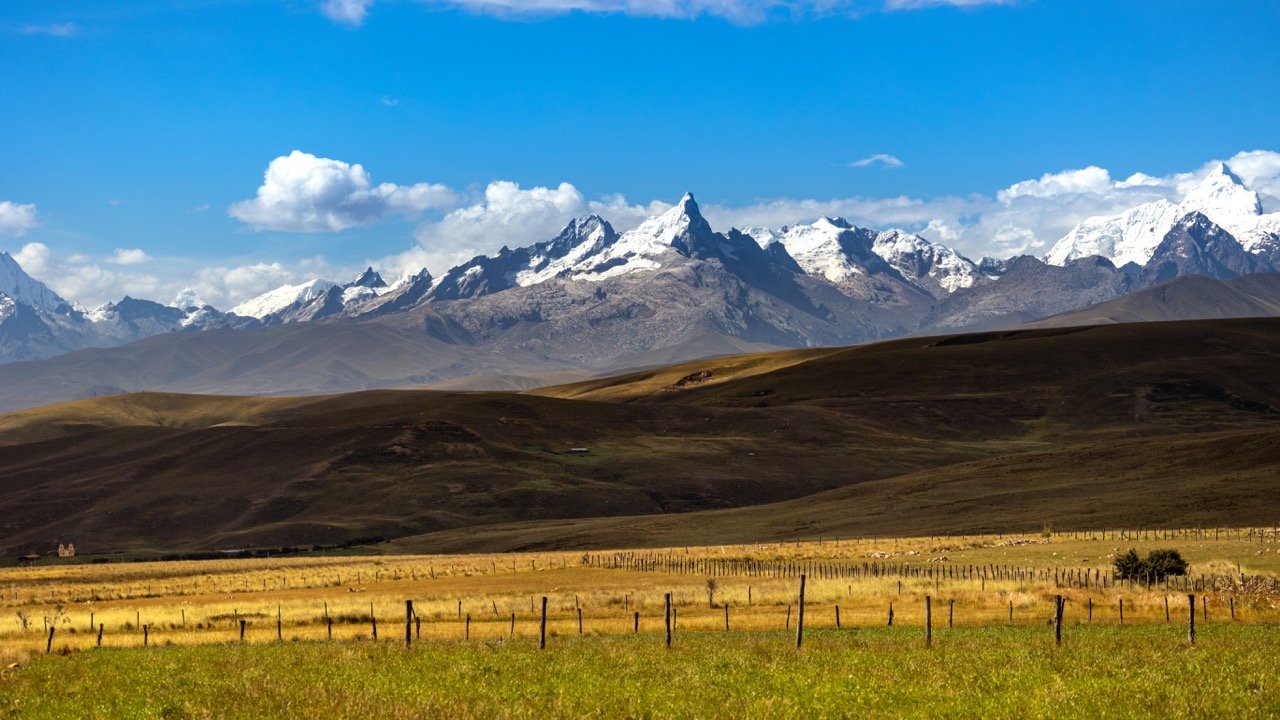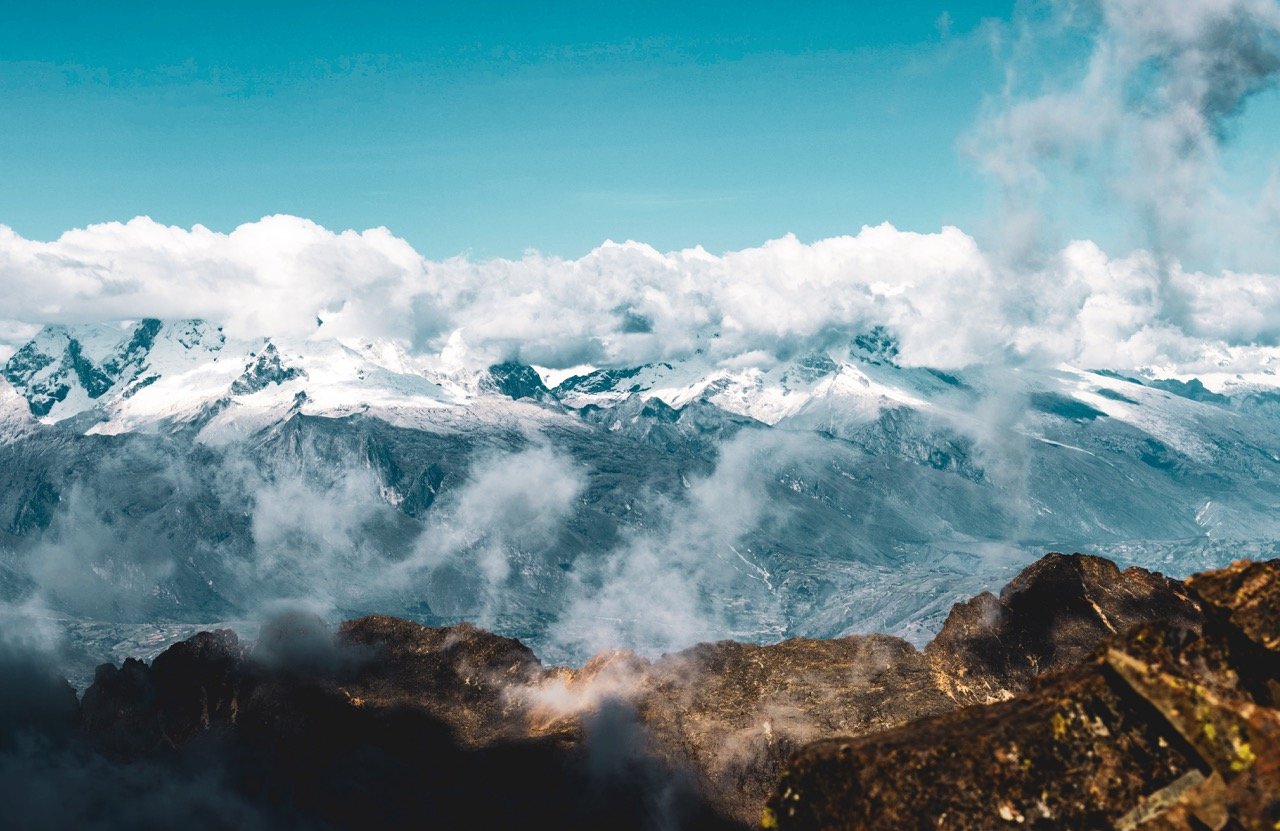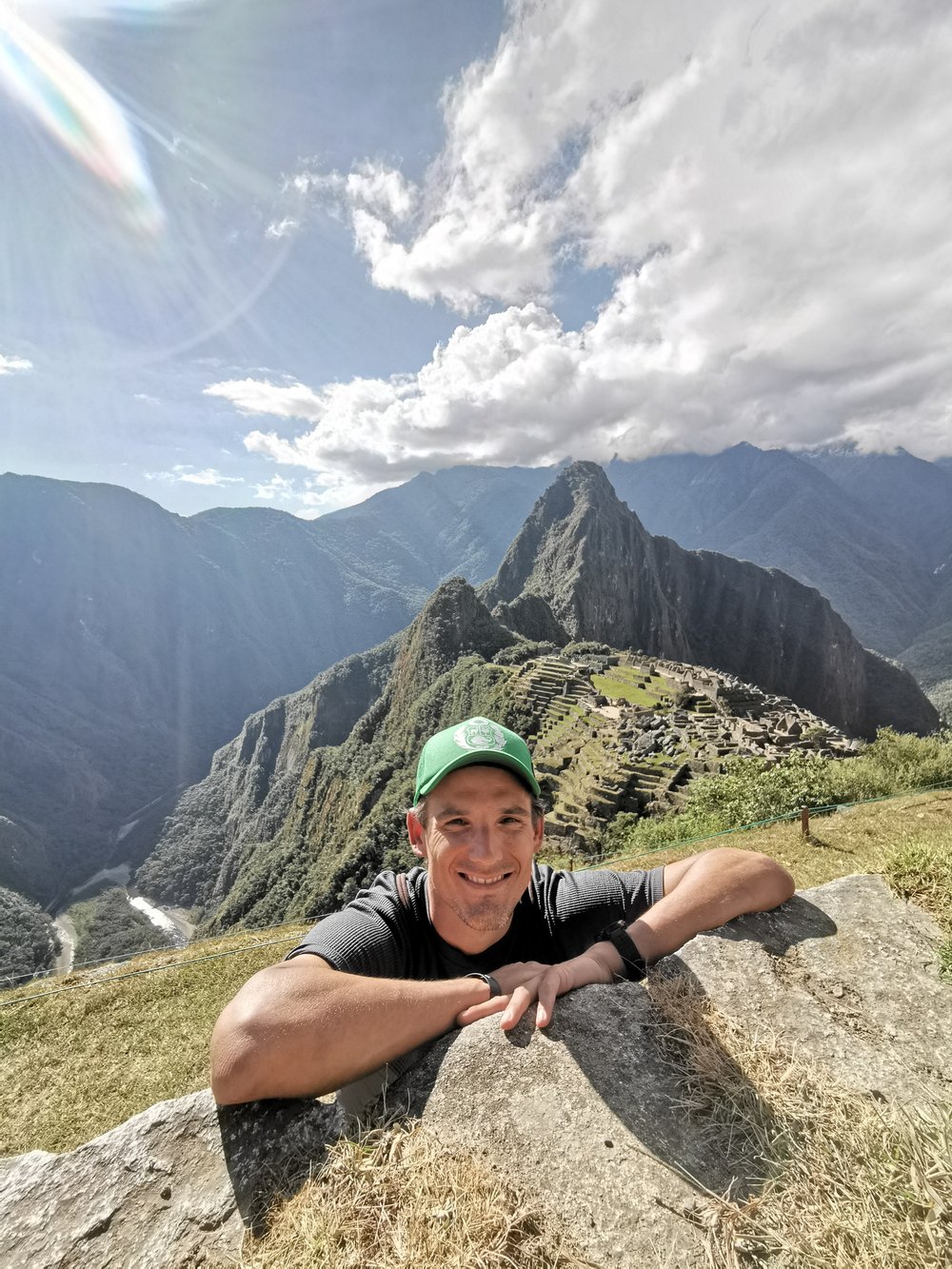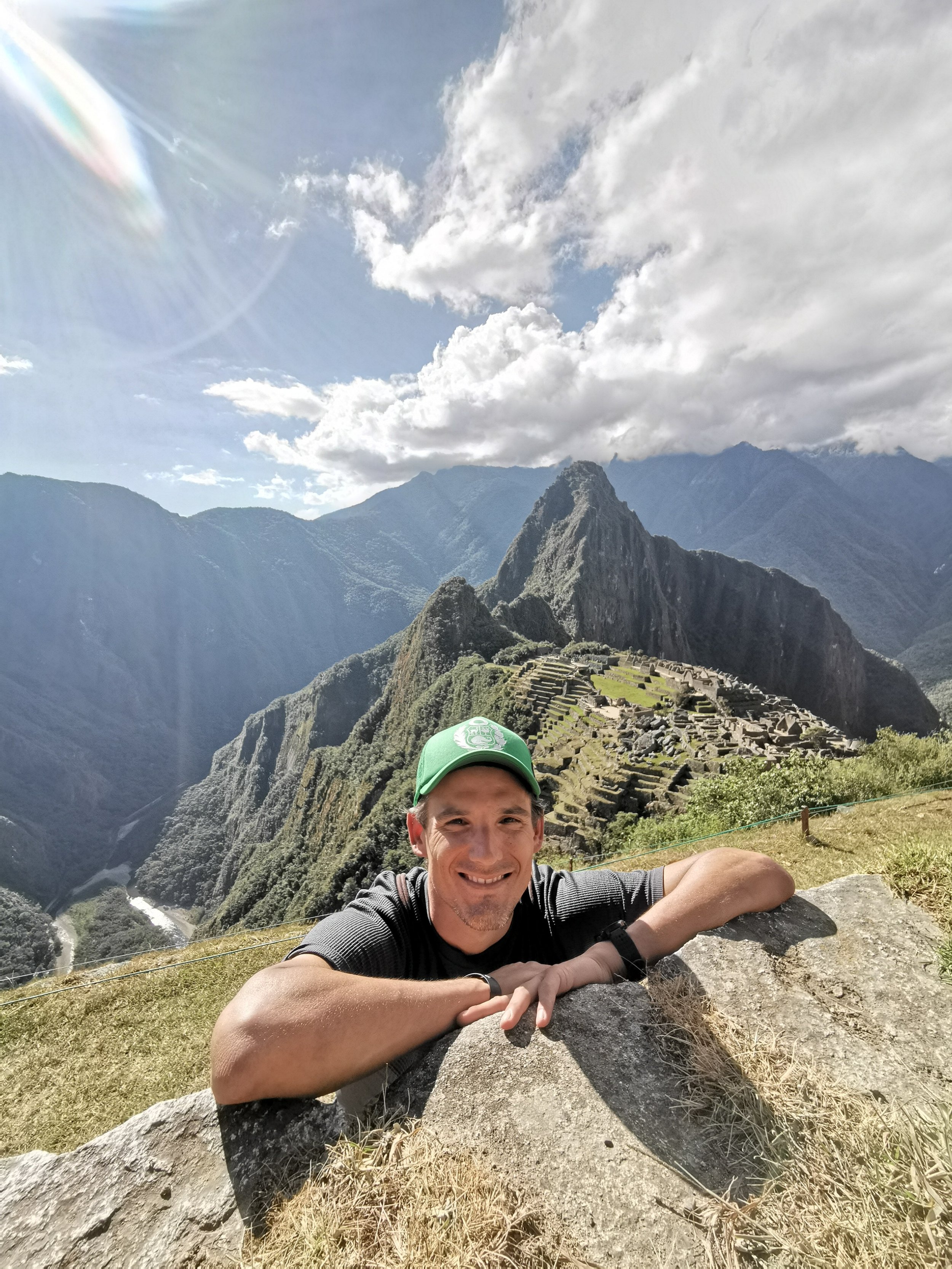Travel Guide to Huaraz - Peru’s Adventure Travel Hub
Set amidst colossal, serrated peaks permanently capped with snow and ice and rising out of emerald-hued valleys and above glimmering lakes, Huaraz is a true mountain town.
Surrounded by the soaring peaks of the Cordilleras Huayhuash and Blanca, Huaraz is home to Peru’s best multi-day hikes as well as phenomenal climbing and mountain biking. It is without debt the country’s outdoors adventure capital.
The city itself is small (about 120,000 people), but makes for an excellent base from which to explore these incredible mountain landscapes. You’ll find all sorts of outdoors stores, outfitters, tour operators, and everything else you need to plan your hikes and adventures.
If outdoor thrills are the thing that gets your heart racing, this is undoubtedly where you want to come in Peru. And with so much to see and do, you should set aside at least a couple of weeks to do the region justice and truly drink in the majesty of the precipitous surroundings.
There are the internationally famous treks, like the Santa Cruz Trek and the Huayhuash Circuit, whose sublime scenery and lack of restrictions/regulation put them up there with the Inca Trail and W trek (in Chile) in the conversation about South America’s top hikes.
But for me, it is the lesser-known hikes that often end up being what captivate the most: the trip up to mountain-flanked Laguna Parón north of Huaraz, or the adventurous tramp across the mountains to one of South America’s most formidable pre-Inca settlements, Chavín de Huantar.
No matter where you go, which hikes you choose, or what you do here, Huaraz and the cordilleras will leave you awestruck.
Table of Contents
Plan your itinerary with local help
If you could use some help figuring out a plan for your trip, schedule a Peru travel consultation with one of our Local Experts!
These are one-hour Zoom calls where you’ll get to chat with a Peru-based travel pro about the trip you’re planning and they’ll share their tips and advice, answer your travel questions, and help you perfect your itinerary.
Where is Huaraz
Huaraz is about 250 miles (405 km) north of Lima, an approximately 8-hour drive. It sits in a region of the Andes mountains dominated by extremely high peaks known as the Cordilleras Blanca and Huayhuash.
It sits at an altitude of about 3,000 meters.
To the northwest of Huaraz, once you leave the mountains behind, is Peru’s mostly arid northern coastline. To the southeast, roads eventually lead into the country’s Central Highlands.
How to get here
The road between Carhuaz and Chacas. Photo: Lamder, CC BY-SA 4.0, via Wikimedia Commons. Cropped from original
Because Huaraz is so remote and so far from almost any other large city, almost every route there first passes through Lima.
The easiest way to get to Huaraz is by direct flight from Lima. The airline LATAM runs one nonstop flight every day, usually departing at 7:00 in the morning. This is the only non-charter domestic flight that arrives to Huaraz’s airport, so you cannot get there by plane from anywhere else.
Because there’s only one flight to Huaraz (and from just one city), most travelers get there by bus, again with the vast majority of departures being from Lima or making a change there.
From Lima, high-end long-distance bus companies like Cruz del Sur and Oltursa offer both day and overnight buses starting at around $20 USD for a one-way ticket. The journey takes about 8.5 hours and you’ll usually have one morning departure and then a few in the late evening.
The only other major city with a decent connection to Huaraz is Trujillo, on Peru’s north coast. Buses from there also take around 8 hours.
Within the Huaraz region you have standard bus service for a few main nearby destinations like Caraz, Yungay, and Chavín de Huantar.
For less traveled routes that don’t merit a major bus company running a regular service, informal combis or colectivos will be your best bet.
Why visit?
Photo: Jeremyfrimer, CC BY-SA 3.0, via Wikimedia Commons
The principal reason to visit Huaraz is simply because it is the gateway to the Cordilleras. The largest city in the region, it’s both a regional and tourism hub and is the logical place to begin any trip to this part of the Andes.
Reasons to visit the cordilleras are myriad, but the most obvious is to enjoy outdoors activities in some of the highest mountains in the world. These ranges contain the greatest spread of 20,000+ foot peaks anywhere outside of the Himalayas and you could spend weeks exploring them.
All around these mountains the panoramas beggar belief, the hiking is some of the best in the world, the rock climbing and mountain biking is incredible, and small villages provide a unique look at traditional high mountain life. There are hiking routes to appeal to every activity level, with plenty of day hikes and many multi-day circuits of all different lengths.
An additional plus of visiting is that the regional hubs of Huaraz and Caraz are very well set up for tourism, and getting out into the mountains is quite easy.
Even for those who don’t want to spend many days hiking and biking, there is still reason to come. You can explore mighty pre-Inca civilizations like Chavín de Huantar, experience the culture of little mountain towns like Chacas, enjoy excellent bars and restaurants in Huaraz, or just kick back at a mountain lodge and marvel at the incredible scenery all around you.
What is Huaraz like?
Huaraz. Photo: Uwebart, CC BY-SA 3.0, via Wikimedia Commons
Huaraz itself is pretty uninteresting and visually very unspectacular. However, it’s a busy little city and a pleasant base from which to explore the mountains.
In town, you’ll find everything you need for your travels; gear outfitters, tour operators, trekking companies, transportation services, decent hotels, and some good restaurants and bars.
Around you, the views of the nearby peaks are superb and there are several good nearby acclimatization hikes that will help you prepare for the 4,500+ meter elevations that you’ll experience when hiking and mountaineering in the area.
The town also has an interesting museum that is worth checking out.
But remember, you don’t come to this region to visit Huaraz in its own right; you’re here to enjoy the majestic scenery that surrounds it.

Connect with Nicho, our Lima-based local expert, for help perfecting your itinerary, answers to all your travel questions, and fabulous local tips for a better visit!
What mountain ranges are nearby? (the Cordilleras)
The Cordillera Blanca seen from a peak in the Cordillera Negra. Photo: Carlo Daniel Real Ayala, CC BY-SA 4.0, via Wikimedia Commons.
“Cordillera” means mountain range in Spanish, and there are of course cordilleras all over the country. But in Peru, people often say “las cordilleras” specifically to refer to the three principal ranges found in the Ancash region (of which Huaraz is a part). These are the Cordilleras Blanca, Negra, and Huayhuash.
Below is a quick overview of each:
Cordillera Blanca
This is the highest mountain range in Peru and one of the most significant in the Andes. It is renowned for its stunning snow-capped peaks, including Huascarán, which is the highest mountain in the country and the fourth highest in South America.
The Cordillera Blanca is a fantastic hiking destination, and it boasts magnificent lakes, glaciers, and challenging towering peaks.
Cordillera Negra
Located west of the Cordillera Blanca, the Cordillera Negra is a smaller mountain range known for its dark volcanic rock, which gives it its name. Unlike the Cordillera Blanca, this mountain range does not have much in the way of glaciers, the terrain is significantly less rugged, and the elevations are a fair deal lower.
It is still a popular destination for outdoor activities though, especially rock climbing and mountain biking. The views of the Cordillera Blanca, seen from across the Callejón de Huaylas valley (which separates the two ranges), are extraordinay.
Cordillera Huayhuash
To the south of the Cordillera Blanca is the Huayhuash range. This is a remote area that is far less visited by tourists, and although the peaks are slightly lower than in the Cordillera Blanca, the terrain is similar: jagged snow-capped mountaintops, deep valleys, and pristine alpine lakes.
The trekking routes here are very challenging, and the most famous is the 10-12 day Huayhuash Circuit, which is considered one of the most beautiful and demanding treks in the world.
When to visit
Huaraz and the Cordilleras, like the rest of the Peruvian Andes, have a climate that falls into two distinct seasons: dry season and wet/rainy season.
The dry season runs from April through September, with the most popular months being June, July, and August.
The wet season runs from October through March, with the wettest months being January, February, and March.
The dry season has much nicer weather, with clear days and nights, but it’s worth noting that wet season has slightly milder temperatures overall.
Temperatures in Huaraz and the Cordilleras don’t change very much from one month or season to the next though, and in general temperatures range from about 38 to 65 degrees. While the surrounding mountains can get blisteringly cold, Huaraz itself is never particularly frigid, with temperatures in town almost never dropping below freezing.
As you may have assumed, dry season is the high season for travel in the region, and it’s certainly the best time of year to visit if you’re interested in hiking and outdoor activities.
Wet season sees far fewer tourists, but that’s with good reason - with regular heavy rains and potentially limited visibility, outdoor activities are not especially pleasant during this period.
Dry season - April through September - High season
The slightly chillier, drier weather in Huaraz and the Cordilleras begins in April and lasts through to October, or occasionally even November. This is the best season for exploring the high peaks for which the area is renowned – visibility is much better and rain is much less frequent.
June, July, and August are the months with the least precipitation, and that fact, combined with the period overlapping with summer holidays in North America and Europe, means this is by far the busiest time for tourism in the region.
Rainy season - October through March - Low season
During the low season, you can expect milder but far wetter weather throughout the Huaraz area. Cloud cover, particularly high up in the big mountains, is far more frequent and the best views will often be obscured.
Average monthly precipitation during this season is in excess of 7.85 inches per month: well over three times more per month than it is in the dry season.
But all that cloud comes with a silver lining: crowds tend to stay away from the region’s big hikes this time of year, meaning that if you brave the elements you’ll be rewarded by largely empty trails. Carnival, the biggest party of the year, also takes place in Huaraz in February, so can be a fun time to visit.
For more info on visiting Peru in each season, check out our guide to the best time to visit Peru.
How long to spend
At the very least, you will need at least 5 days to enjoy Huaraz and the surrounding mountains.
5 days give you enough to get situated and do some good hiking. You could spend a day seeing the town and making plans, and then set our for a series of day hikes or do a 3-4 day one like the Santa Cruz Trek.
But really, if you’ve made the effort to get all the way to this part of Peru, it would be much better to spend two or three weeks in the region. A lot of the best hikes, scenery, and panoramas are rather remote, and you need time to get to them and do them. And even for very experienced hikers, the treks can be exhausting, so you’ll certainly want some downtime in between them.
When not hiking, you can explore the excellent archaeological site of Chavín de Huantar, hang out in mountain lodges, visit some hot springs, or just relax in town.
Let me reiterate, there is no point coming to the Huaraz region for just a day or two - it’s too remote, will take you too long to get to, and has far too much to see and do for a quick trip to be worth it.
Huaraz & the Cordilleras are utterly devoted to outdoor activities like trekking and mountaineering, most of which require multi-day excursions/hikes, and significant travel time to even get out to the trailheads. If you’re not especially interested in hiking, mountain biking, or mountaineering, then a trip here likely isn’t worth it anyways, so you can skip the region entirely rather than trying to needlessly fit in a too-quick trip.
Where to stay
A view over Huaraz at dusk
Huaraz is the obvious initial base for any trip to the cordilleras. Anyone arriving to the region will pass through the city and you’ll likely want to spend spend at least a day or two here as you figure out your plan, sort out your gear, and make arrangements with trekking companies and tour operators. You’ll probably also want to spend another day back in town at the end of any multi-day hikes.
If you’re planning on only doing day hikes, you could use Huaraz as your base for the entire time in the area, but you’d still probably be better off also spending a night or two somewhere closer to some of the further hikes you may be interested in.
Here are some of my favorite hotels in the city:
Other towns to consider as bases
Caraz
A smaller and slightly more attractive version of Huaraz, Caraz is well-placed for excellent mountain-biking and trekking routes and has a good selection of tourism facilities/amenities.
Chacas
The cordilleras’ prettiest town, Chacas is somewhere to take a few nigihts’ break from all your hardcore hiking and climbing. There’s nothing really to do here, but the pleasure of a visit lies mostly in soaking up the special atmosphere of this pretty little mountain town filled with brightly-painted houses.
Chacas is also famous for the Don Bosco Wood Carving Cooperative, which vastly improved the fortunes of the locality over the past decades.
Chavín de Huantar
This tiny town doesn’t offer much in its own right, but its the best base from which to explore the really excellent ruins of the same name. Stay overnight and visit the ruins first thing the following morning so that you can see the site when it’s almost empty, before the day-trippers from Huaraz arrive.
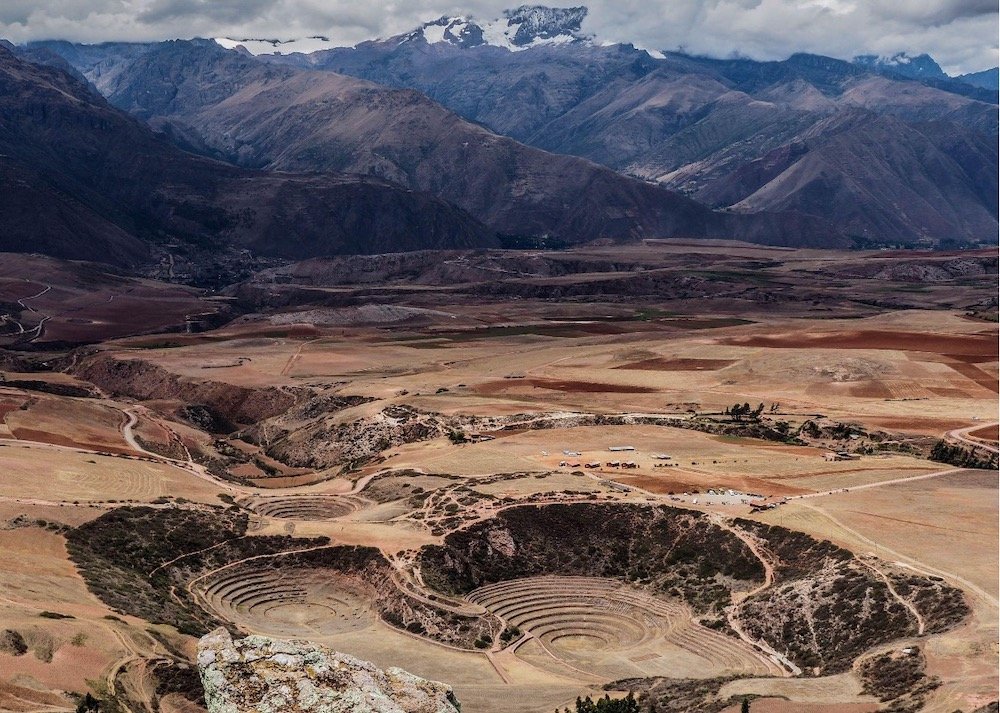
How to get around the region
Somewhere in the Cordillera Huayhuash. Photo: James Sykes, CC BY-SA 4.0, via Wikimedia Commons
Standard buses
Standard buses travel regularly between the major towns and destinations in the region. Of these, the most popular routes are Huaraz to Caraz (2 hours), Huaraz to Yungay (1 hour 15 minutes), and Huaraz to Chavín de Huantar (around 2.5 hours).
For each of these, regular public buses depart at least every couple of hours throughout the day.
For destinations north of Huaraz, most buses are ones coming from Lima and continuing on to destinations even further north, picking up passengers in Huaraz along the way. For southbound routes, it’s the opposite: the bus will have begun its journey somewhere further north and will end it in Lima.
A reliable operator serving these destinations is Movil Tours.
Combis and colectivos
For many of the destinations that you’re likely to be interested in visiting, especially ones outside of the major cities/towns in the region, you’ll almost certainly be reliant on unofficial (but very common and safe) forms of transportation called combis and colectivos.
From Huaraz and Caraz, you will find many colectivos every day heading out all over the region. Rarely will these buses have planned stops at your destination (i.e. trailheads), but as long as it’s along the route, the driver will stop and let you off. If not directly off the main road, expect to need to walk to where you’re headed - the driver will not detour for you.
Before getting on any colectivo, always make sure to ask where they’re headed and if they’re going to pass by where you want to go. Also, always be sure to check with the driver about when they or another shuttle will be passing back in the opposite direction. You don’t want to get stranded somewhere remote.
Because some routes may have limited daily departures, you should always inform yourself the day before about what time colectivos for your destination typically depart at.
Taxis and private drivers
You’ll find taxis and private drivers in Huaraz and a few main towns popular with tourists. They can be hired to bring you to most places within a reasonable drive of key transport hubs. While expensive by local standards, the fares are very affordable by most travelers’ standards.
Tour operators and tour buses
Local tour agencies, which organize excursions to many of the major sites of the region, are also an option to get to some out-of-the-way destinations. For example, Laguna Parón is often visited as part of a guided tour from Caraz or Huaraz.
What to see & do in Huaraz
1. Have a night on the town
Huaraz has some of the best restaurants and bars in the Peruvian Andes outside of Cusco and the atmosphere in town is often lively with lots of hikers either preparing to set out for treks or returning from them.
For starters, sample some of the best pizza in Peru’s mountains at Mi Comedia and then sip some excellent craft beer at the very cool Los 13 Búhos
2. Check out the stone sculptures at Huaraz’s Museo Regional de Ancash
The most interesting sight in Huaraz itself is this fascinating little museum near the Plaza de Armas (central square), which boasts a fantastic number of ancient stone carvings, many from pre-Inca cultures like the Wari. It’s deserving of an hours’ look round.
3. Acclimatize during the stunning hike to Laguna Churup
Brilliant as an acclimatization hike for outdoor-loves bound afterwards for bigger treks, Laguna Churup is one of the most popular treks near Huaraz. Start from the village of Llupa, 9 miles east of Huaraz for the about seven hour out-and-back climb to this sparkling lagoon at 14,750 feet altitude below Nevado Churup.
Photo: PercyDextre, CC BY-SA 4.0, via Wikimedia Commons
4. Visit Carhuaz
This little town north of Huaraz with one of the region’s loveliest plazas and most interesting Sunday markets makes a nice place to linger, potentially overnight, for a break on the way between Huaraz and adventures among the big peaks of the Cordillera Blanca.
5. Remember the fallen at Yungay’s Campo Santo
Huddling below the formidable double-peaked mountain of Huascarán, the highest point in Peru and in all the Northern Andes, Yungay is mainly famous for the tragedy that took place in May 1970 when an earthquake dislodged rock, ice and soil from the peak and buried the settlement completely.
This is the beautiful memorial to the town and its citizen who lost their lives that day, where gardens and a recreation of the old cathedral mark where the original Yungay lay. For me, this is also a powerful reminder of what this mountain country is capable of, and why it should be respected.
6. Take a dip in Monterrey’s hot springs
These natural hot springs are not Peru’s most photogenic, but hikers and climbers won’t mind: it’s a lovely way to relax post-adventure, though facilities are quite basic. Monterrey is a few miles north of Huaraz, connected by regular combis or a reasonably priced taxi ride.
7. Take in the views at the dazzling Laguna Parón
A candidate for the most magnificent view in the cordillera region, Laguna Parón sits at over 13750 feet above sea level and is one of Peru’s prettiest mountain lakes. Surreally blue waters spread out below a striking backdrop of mountains including 20,000+-feet peaks Charcaraju and Huandoy, and you can hike along the lakeshore.
Visit on a half-day tour from Caraz (day tours run from Huaraz too, but I recommend doing one from Caraz which is much nearer).
8. Go downhill mountain biking at the Cañon del Pato
Saddle up for some of the best downhill biking in South America, at the point where Cordilleras Blanca and Negra meet: the Cañon del Pato in Callejon de Huaylas.
A narrow road (be warned – buses and other vehicles also use it) corkscrews between awe-inspiring walls of rock, teeters along precipices, and dips through 35 tunnels during its most hair-raising section between Caraz and Huallanca to the north.
Hire bikes and get trail maps from adventure agencies in Caraz.
9. Do a day hike to Laguna 69 from Yungay or Caraz
Laguna 69 is one of the defining day trips in the cordilleras: a beautiful, shimmering blue mountain-rimmed lake, accessed off the road from Yungay to Yanama (the same road as for Santa Cruz Trek trailhead, Vaqueria, from Yurac Corral).
Climb three hours from the trailhead to the lake at a breath-sapping 15000 feet which clocks cracking views of Peru’s highest peak Huascarán en route: it’s just under nine miles out and back.
It’s one of those places for which I recommend considering going with an arranged tour from Caraz, because of the infrequency of public transport.
10. Relax in a mountain lodge
I know what you’re thinking: relax? In the region with Peru’s best trekking and mountaineering? For a break between exertions, simply unwinding and looking out at the gorgeous peak-peppered scenery is the way to go, believe me.
Here, Llanganuco Lake Lodge, a 45-minute drive from Yungay, leads the pack: perched by Laguna Queushu, it’s a perfect place to be out alone and in peace in the middle of the uninterrupted mountain landscapes hereabouts.
11. Spend a day in Chacas
Visiting the idyllic little mountain town of Chacas shows off the cultural side to the Huaraz region. The pretty place is a superb example of what an intelligently-run cooperative can do, where the Don Bosco Woodcarving Cooperative has, since the 1970s, trained youngsters in woodcarving and other practical skills.
These skills have been used for major projects: the rebuilding of Chacas’ earthquake-damaged church in exquisite Renaissance style, the brightening up of the town’s housefronts and and the financing of numerous other local projects from providing irrigation to constructing mountain refuges.
12. Tackle the famous Santa Cruz Trek
One of the continent’s most famous treks snakes through the Cordillera Blanca north of Caraz and Yanama. Generally hiked southeast-to-northwest from Vaqueria, on the Yungay-Yanama road, to Cashapampa 15.5 miles north of Caraz, this three-to-four-day odyssey traverses some of the most spectacular mountain scenery in the Americas.
There is no need to wait for a permit or be obliged to go with a guide, as for the Inca Trail, which means you can go under your own steam and enjoy the fierce beauty of peaks that crest the 20,000-foot contour from pristine lake-spattered valleys and passes.
The Vaqueria Pass. Photo: TMbux, CC BY-SA 3.0, via Wikimedia Commons
13. Explore the ancient ceremonial center of Chavín de Huantar
One of the most impressive ancient pre-Inca ceremonial centers in Peru, Chavín de Huantar should pull your attention away from the jagged mountain panoramas for a day.
The buildings here were raised between 1200 BC to 500 AD and are mainly attributed to the Chavín culture: they fan out around a carved monolith known as the Lanzón de Chavín. There is an excellent museum in Chavín de Huantar that exhibits many of the best finds from the site, too.
I recommend an interesting, little-trodden two-day trek from Olleros to Chavín de Huantar as the perfect approach which also gets you great hiking through mountain scenery without the need to spend the time on the trail that the Santa Cruz Trek or Huayhuash Circuit demand.
Photo: Photo: Sharon odb, CC BY-SA 3.0, via Wikimedia Commons. Cropped from original
14. Pay a visit to the Pastoruri Glacier
This curved, bowl-shaped glacier in the south of the Cordillera Blanca, 47 miles south of Huaraz, is the most accessible of the glaciers remaining in the Andes. Most people come up to the 16,500 ft glacier viewing point as part of a day trip from Huaraz.
You’ll need to walk 40 minutes from the car park to see this formidable icy sight which – given how much it has melted in recent decades – may not be around forever.
15. Rock-climb in the Cordillera Negra at Hatun Machay
The Cordillera Negra gets overlooked in favour of Cordilleras Blanca and Huayhuash in terms of the area’s treks, but for climbing, Hatun Machay is top-notch.
There are around 300 climbing routes here, all marked and ranging from beginner level to advanced, situated within a stunning bosque de piedras (rock forest) off Highway 3N about 25 miles south of Catac.
Get a taxi here from Catac, itself on the Huaraz-Lima road 23 miles south of Huaraz and passed through by Huaraz-Lima buses. By the time you’ve goten out here, you’ll want to spend most of the day here, even if you’re not climbing: just hiking around the rock forest and having a picnic is beautiful.
16. Catch incredible views at Chiquián’s Mirador San Juan Cruz
It’s worth your while coming to Chiquián, a town close to the beginning of the Huayhuash Circuit trek, solely to hike up from the Plaza de Armas (central square) to this hill, topped by a cross.
Allow an hour or two to climb up, gaze at some of the best cordillera views around (including Yanupajá, Peru’s second-highest summit) and come down again.
17. Do the 10-day Huayhuash Circuit
Making a high-altitude lap of many of the Cordillera Huayhuash’s mighty peaks, this is another candidate for South America’s best trek. It’s a lung-busting nine or ten days over multiple mountain passes entailing ascents of up to 3900 feet in a day, in a circuit radiating out from the little town of Llamac (many trekkers start at Pocpa and finish in Llamac).
You get to loop round a stunning assortment of summits, several surpassing 20,000 feet above sea level, seeing many mountain-flanked lakes, dramatic waterfalls and time-frozen traditional villages as you go.
A view of Huascaran from the Paso de Zorro route. Photo: SolcitoAndino, CC BY-SA 4.0, via Wikimedia Commons
How to spend 1-3 weeks in and around Huaraz
5-7 days - enough time for one big hike
Five days is the bare minimum you need for this outdoors-focused region where multi-day treks and climbing/biking trips in the mountains are the key reason to come.
With 5 days, you’d want to arrive to Huaraz and immediately head to the town of Yungay, where you’d stay overnight. The next day, set out on the three-to-four-day Santa Cruz trek by taking a morning combi/colectivo to the trailhead at Vaqueria.
With a determined three days of hard hiking and no side-trip hikes, you’ll be finishing up the trek on the morning of your fifth day, and heading back to Caraz or Huaraz.
If you can spare an extra day or two, it’s better off to spend your first day in Huaraz, staying overnight in the city. Your other extra day would give you the time to set off on a side hike during the Santa Cruz trek, or just spend more time in Caraz, which would allow for a day trip out to somewhere like Laguna Parón.
2-3 weeks - for multiple multi-day hikes and extensive mountain adventures
With 2-3 weeks, you have a whole world of possibilities. Spend at least a night at the beginning and end of your mountain adventures in Huaraz, doing an acclimatization hike at Laguna Churup on your arrival. The Laguna Shallap hike, which departs from the same trailhead is another option, but is much longer.
Next, set out on the Santa Cruz trek, but extend it to the full four days, which allows for side-trip hikes to spots such as the stunning mountain-flanked Laguna Arhueycocha.
Follow the trek up with a few days in Caraz, taking a daytrip out to the beautiful Laguna Parón, another day spent doing some downhill biking at Cañon del Pato, and more trips out to the Chavín de Huantar archaeological site and the Pastoruri Glacier.
Whenever you’re ready to leave Caraz and hit the trails again, head south to Pocpa, the jumping off point for the incredible nine-day Huayhuash Circuit trek.
Both multi-day treks I’ve mentioned can be done on your own, but there are also many agencies in Huaraz that organize group treks with a guide.



Connect with Nicho





